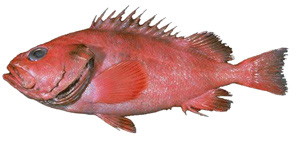

|
|
|
|
|
The shortraker rockfish (Sebastes borealis) can grow to 48 in. (120 cm) in size and reach 50.6 lb. (23 kg) in weight, making them one of the largest rockfishes. Shortrakers smaller than 14 in. (35 cm) are rarely found. The shortraker name refers to their knob-tipped stubby gill rakers, and its Arctic habitat inspired the Latin name borealis, meaning "northern". They are also called buoy keg, snapper, and blackthroated rockfish, among other names. When viewed underwater, shortrakers are white, having blotches and saddles that are pink, pink-orange, or red in color. There may be black on all fins and white on the tips of the dorsal fin. They appear orange-pink or reddish orange when out of water. The shortrakers also have large pores on their lower jaws and occasionally black tumors can develop on their skin. Shortrakers are often confused with the red-colored rougheye rockfish. Shortrakers are common from British Columbia to eastern Kamchatka, but can be found from the Bering Sea and Aleutian Islands south to Japan and southern California. They are found at depths of 83 ft. to 3,960 ft. (25-1,200 m). According to Alaska longline surveys and trawl studies, the shortrakers are most abundant between 990 ft. and 1,650 ft. (300-500 m). The older shortrakers are found in deeper water than the younger ones. These fish live alone or in small groups on steeply sloped boulder fields surrounded by soft substratum and commonly ascend up to 33 ft. (10 m) above the seafloor. Shortrakers have been found to prey on lanternfishes, squid, octopi, shrimp, crab, krill, and other small crustaceans. 
Shortrakers have been aged to 157 years. Russian researchers have estimated the age of maturity at 9-12 years. From Alaska to Oregon maturity size commonly ranges between 13 in. to 18 in. (34-45 cm). Reports indicate that spawning occurs at depths of 990 ft. to 1,650 ft. (300-500 m) during June and July in the western Bering Sea and off Kamchatka. The females have egg-filled ovaries that are cream-colored, which is unusual among rockfishes. Embryos fully develop from March to July and larval release can extend into late summer or early fall. This species is important (or moderately important) to the commercial longline and trawl fisheries from Washington to the Bering Sea. They are occasionally taken off Oregon and California. In other fisheries, shortrakers are taken as incidental catch. Adapted from Love, M. 2002 Sebastes borealis, p. 136-137. In M. S. Love, M. Yoklavich, and L. Thorsteinson, The rockfishes of the northeast Pacific. Univ. California Press.
|
|
|
|
|